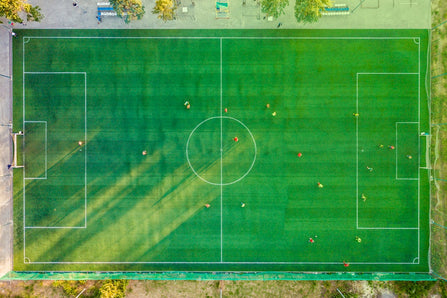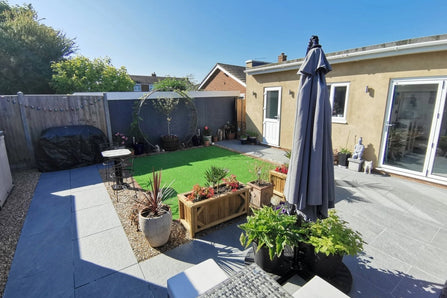Easy and Affordable Ways to Level Your Garden Without Heavy Equipment
Posted on by James Higgins
Whether you’re on a tight budget, or you prefer the DIY approach to a garden makeover, it’s possible to level your garden yourself without the need for heavy equipment and plant machinery. In this article we’ll look at how to level out a garden using minimal equipment, the essential tools you will need for the job, and cover top tips for how to level a lawn the easy way.
Why Level Your Garden?
By levelling your garden you can not only make it look more inviting, but it can create a more practical and usable outdoor space. Garden levelling can also improve drainage and reduce the risk of flooding if your garden slopes towards the house. By creating a level area you can make a more user-friendly area for all to enjoy, whilst improving your soil and lawn quality, creating an easier-to-maintain garden, and reducing the risk of soil erosion.
Benefits of a Level Lawn
By levelling a lawn you essentially create a blank canvas to design your ideal outdoor zone. In addition to the drainage and aesthetic benefits, garden levelling also offers:
-
Improved safety for garden users
-
Potential enlargement of your usable space
-
A better base for artificial grass or decking
-
Easier mowing and garden maintenance for those with real turf
-
The possibility of boosting your home’s resale value.
Common Causes of Uneven Gardens
Unevenness in gardens can be due to natural undulations, waterlogging, or items in the soil. The most common causes of uneven gardens include:
-
Natural sloping
-
Setting soil settlement
-
Flooding leading to erosion
-
Sinkholes and subsidence
-
Buried debris and large stones
-
Tree roots
-
Poor landscaping
-
Season changes
-
Animal damage and digging
-
Pipes and electrical cables
-
Heavy use of certain areas.
The good news is that most of these causes, except for some more extreme inclines, can usually be fixed and improved by levelling.
Can You Level a Garden Without Heavy Equipment?
Garden levelling is easier using heavy machinery, but this can be very expensive, and many gardens or yards may not be accessible to plant machines. In fact, if you’re looking at how much to level a garden professionally it can cost anywhere between £1,000 and £10,000, depending on the size and complexity of the project. Here’s how to level a garden yourself, without using heavy equipment.
Why Level Your Garden by Hand
Levelling a sloping garden yourself can bring cost-saving advantages, but it’s also ideal when you want to focus on smaller areas. The benefits include:
-
A low-cost DIY approach
-
Ideal for small or sloped gardens
-
Easier for gardens with limited access
-
Great for renters and temporary solutions
-
Less of a risk to wildlife
-
Reduced risk of damaging buried pipes or electrical cables.
Step-by-Step Guide: How to Level a Garden by Hand

Whether it’s a natural slope that you want to level off, you’d like to install artificial grass, or simply you want to repair any damaged areas to create a smooth surface, follow this easy step-by-step guide to how to level a garden by hand.
Step 1: Make Sure You Have the Right Tools & Materials
Before you start, you’ll need to make sure you have a few basic tools to hand. How much to level a garden may depend on your own capabilities, so it’s best to start in a targeted area and slowly work your way across the space.
Recommended Garden Levelling Tools
The best way to level a garden without heavy machinery is to use a good old-fashioned spade, alongside some other key tools. It can be heavy work, so enlisting others to help you will make the process easier and faster. You will need:
-
Spade or shovel
-
Measuring tools
-
Rake for clearing stones and debris
-
Wheelbarrow
-
Lawnmower (if you have real grass)
-
Garden string and stakes
-
Spirit level or straight board
-
A garden levelling tool such as a lawn roller or tamper
-
Skip or skip bags
-
Turf, decking, patio materials or artificial grass accessories to lay on top.
Step 2: Measure the Area
Before you start levelling a lawn you’ll need to measure the space. Use your string level to mark out the areas that will need to be levelled. Be sure to measure the height difference between the top areas you want to remove and the lower levels.
After you’ve levelled the lawn you may need to re-measure the area before fitting your artificial grass, decking or other materials, for a more accurate calculation for materials.
Step 3: Remove Turf or Debris
Mow any grass present and dethatch it if needed, to make the task easier. You can then cut and roll up any turf, which can be saved for re-use if needed.
Next, start to shovel the soil away using your spade and be sure to remove any rocks, roots or rubble. The best way to level a garden and keep it looking flat is to take time to remove any and all debris which could cause any further bumps, slopes and imperfections.
Step 4: Level the Soil
Once you’ve removed the hills, turf and rubble, you’ll need to level the remaining soil. Redistribute topsoil to even out dips and holes, until you’ve got a flat surface. Rake and compact the area regularly to make sure it keeps its even appearance. Exactly how much to level a garden will depend on how sloped, rubble-filled or damaged your garden was to begin with, but the secret to how to level out a garden to give the best long-term results relies on how diligently you’ve removed stones, roots and other debris, as well as compacted your new base.
Step 5: Finish and Flatten
Finally, it’s time to use a lawn roller or tamper to further compact the newly level surface. Going over the area multiple times will help to reduce the risk of erosion or subsidence in future. You should now water the area lightly and let it settle before adding your new artificial grass underlay, turf, or decking.
What’s the Best Surface for a Levelled Garden?
A levelled garden should have soil underneath, with stones and roots removed, followed by turf, shingle, decking, patio, or an artificial lawn. Think about what you’ll use your garden for, as well as the overall look you want to achieve, and the level of maintenance you’re prepared to give it.
Artificial Grass as a Low-Maintenance Option

Artificial grass is a great option for your newly leveled lawn as it’s hard-wearing, low maintenance and versatile for year-round use. Just think, you could be enjoying:
-
No more mowing or edge trimming
-
No re-seeding or fertilising
-
A usable space for all seasons
-
Creative designs for a striking finish
-
Improved drainage
-
No muddy footprints
-
Easy installation and upkeep
-
The ability to have grassy areas in spaces where real grass won’t grow.
Artificial grass also comes in child and pet friendly options, and will reduce the risk of animal damage making further holes in your lawn to make it uneven again. So, whether you want beautiful stripes, an ultra-realistic finish that looks great in all seasons, or a hard-wearing surface for sports or play areas, our artificial grass guide will help you find your perfect lawn partner.
Why Choose Grass247 Artificial Grass
All our artificial grass offers exceptional quality and a realistic looking appearance, which is tried and tested for longevity, as well as being:
-
Ultra durable
-
Odour-resistant
-
Great for families and pets
-
Simple to keep clean
-
UV-stable
-
Affordable for large or small gardens.
From our budget range to luxury artificial grasses and accessories, we stock a wide range which is backed by our price promise. Browse Grass247’s artificial grass range and see just how luscious your lawn can look for years to come.
Garden Levelling by Hand: The Costs
Levelling a sloping garden may be slightly more tricky, but it’s still possible to do by hand to save money. It will save a significant amount of your budget when compared to hiring someone in to do it, which can cost upwards of £100 per m2, so it’ll only usually involve the cost of your basic tools (which you may already own if you’re a gardener) as well as your time.
DIY Budget Breakdown
To compare, and keep costs down as much as possible, consider at the cost of:
-
Tool rental vs purchase
-
Skip hire vs taking the debris to the household waste centre yourself
-
Shopping around for best soil and topsoil estimates
-
Asking friends and family for help vs hiring someone in
-
Choosing your finished surface based on affordability and ease of maintenance.
Pair Your Levelled Lawn with Grass247 Artificial Grass
Artificial grass is a popular finishing touch as it’ll make your newly levelled garden low-maintenance and looking lush in every season. It can help make your space more usable, creating a modern and inviting focal point for any outdoor area. It’s easy to install, simple to look after, and is versatile enough to be installed almost anywhere.
Transform your garden today: shop easy-to-install artificial grass from Grass247 and enjoy a smooth, maintenance-free outdoor area all year round.



